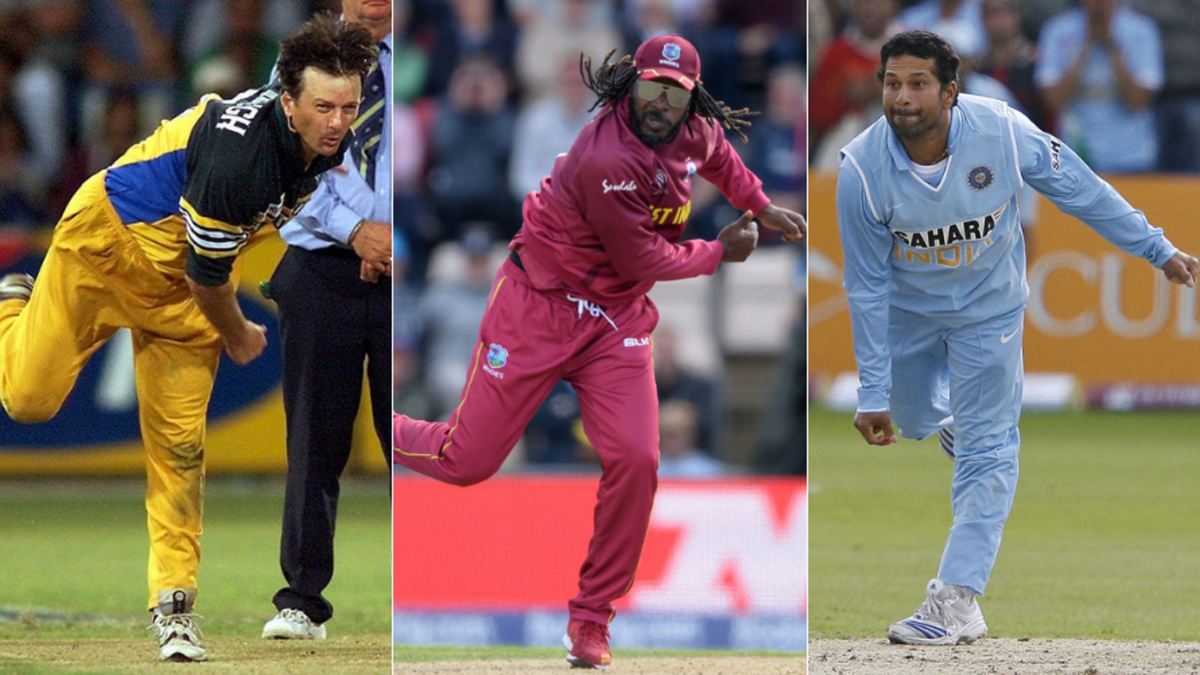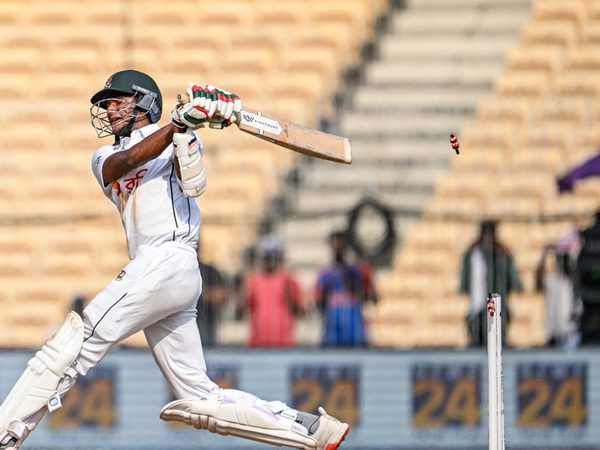
Aadya Sharma ranks the best part-time bowlers in ODI cricket, who progressed from occasionally turning their arm over to becoming key pieces in their teams’ bowling attacks.
What exactly is a part-timer? It’s a role that, the better you perform in it, the less you qualify to be considered one. Perhaps the test is akin to United States Supreme Court Justice Potter Stewart’s 1964 judgement of what consitutes obscenity: “I know it when I see it.”
In our estimation, the likes of Sanath Jayasuriya, Shoaib Malik, Mohammad Hafeez, Yuvraj Singh, Andrew Symonds etc, were all considered genuine all-rounders in the format and so aren’t part of the list.
It’s also a role that is going out of fashion somewhat, with more aggressive batsmen taking toll of any low-quality overs. This list is largely made up of cricketers from the 1990s and 2000s, and only one active international player. The two decades shaped one-day cricket to the form we currently know, and part-time bowlers became an integral element of it, with some of them almost as good as any specialist bowler in the side.
Notable omissions: Michael Clarke, Allan Border, Saleem Malik, Virender Sehwag, Marlon Samuels
The tweakers
The best: Carl Hooper
193 wickets @ 36.05, BBI: 4-34
Bunny: Allan Border, 7 times in 20 matches
Hooper’s lazy trudge to the crease and languid action had a separate fan base in the Nineties. The off-breaks that followed, which were highly effective in both formats, were equally admired. At the time of his retirement, Hooper was West Indies’ third-highest wicket-taker in ODIs, behind only Courtney Walsh and Curtly Ambrose, and while he never claimed a five-wicket haul, he was often their go-to partnership breaker.
The rest
Aravinda de Silva
106 wickets @ 39.40, BBI: 4-30
Bunny: Shivnarine Chanderpaul, 4 times in 15 games
One of Sri Lanka’s all-time batting greats, Aravinda’s small frame delivered crucial overs for the team through the Nineties. At the very top was his 3-42 against Australia in the 1996 World Cup final, which was followed by a top-class century, a game that typified his all-round credentials. Hardly used as a bowler at the start of his career, he claimed two four-wicket hauls by the end of it, the last of them being in his final year of international cricket.
https://www.youtube.com/watch?v=4TadZwETfrk&ab_channel=CricketSpring
Viv Richards
118 wickets @ 35.83, 2 five-fors, BBI: 6-41
Bunny: Kapil Dev, 7 times in 30 matches
For a batsman renowned to boss over hapless attacks, Richards’ off-breaks were quite handy as well, though you fancy if he ever came up to bat against himself, destruction might have resulted. He took 118 wickets in 131 innings, and got the better of established batsmen on multiple occasions, with Kapil Dev, Kepler Wessels and Allan Border among his top victims. His best came against India in Delhi in 1989, when he took a six-wicket haul, including three wickets off four balls.
Sachin Tendulkar
154 wickets @ 44.48, 2 five-fors, BBI: 5-32
Bunny: Inzamam-ul-Haq, 7 times in 52 matches
India’s evergreen part-timer could bowl it all, from brisk medium pace to canny off- and leg-breaks, including a killer googly (ask Moin Khan). If it weren’t for his constant run-ins with injuries, Tendulkar would have bowled far more, but in the first half of his career, was often called on to break partnerships or deliver clutch overs at the death. He took the sixth-most wickets by an Indian ODI bowler in the 1990s and was once the second-ranked ODI all-rounder in the world.
Chris Gayle
167 wickets @ 35.48, 1 five-for, BBI: 5-46
Bunny: Jacques Kallis, 4 times in 26 matches
A 20-year-old Gayle gave a fine impression of his bowling abilities when he gave just two runs while defending five off the last over against England in the 2000 NatWest series. The Player of the Match performance was in his first year of international cricket itself, after which he was regularly called on to chip in with overs, and often, be the designated partnership breaker. The overs dried as he entered his second decade of ODI cricket, but not before he took three four-wicket hauls and a five-for.
Grant Flower
104 wickets @ 40.62, BBI: 4-32
Bunny: Rahul Dravid, 3 times in 26 matches
A solid opening batsman who later found success down the order, Flower was also an effective left-arm spinner who helped increase the depth of a strong Zimbabwean bowling attack. Before the emergence of Ray Price, Flower combined with Paul Strang to shore up the spin resources. Time and again, however, his problematic bowling action was called into question, but he’s still their fourth-highest wicket-taker in the format.
The military medium pacers
The best: Steve Waugh
195 wickets @ 34.67, BBI: 4-33
Bunny: Carl Hooper, 7 times in 34 matches
Waugh was such a regular fixture in the Australian bowling attack of the 1990s that it’s difficult to exactly bracket him in the part-timers’ list. He once admitted that his bowling kept him in the side in the early days of his Test career, but the effectiveness of his gentle medium turned out to be a welcome bonus for Australia. Their fourth-highest wicket-taker in the Nineties, he got the better of Tendulkar, Lara and Richards thrice each.
https://www.youtube.com/watch?v=bWYOK_BKeSY&ab_channel=robelinda2
The rest
Hansie Cronje
114 wickets @ 34.78, 1 five-for, BBI: 5-32
Bunny: Ajay Jadeja, 4 times in 32 matches
Sachin Tendulkar once said that he just didn’t enjoy facing Hansie Cronje. It’s no surprise, then, that he was dismissed five times in 11 Tests to him. In ODIs, Cronje was the ideal sixth bowler, using the old ball to stifle run flow and force batsmen into making an error.
Sourav Ganguly
100 wickets @ 38.49, 2 five-fors, BBI: 5-16
Bunny: Shahid Afridi, 4 times in 47 matches
Ganguly’s pace was hardly menacing, and he found assistance only in swinging conditions, but he still managed to make the most of his limited abilities to become a serious fifth bowling option in one-dayers. While India could never quite fill the void left by all-rounder’s void left by Kapil Dev, Ganguly, along with Ajay Jadeja and Robin Singh combined to chip in with their medium pace in the late 1990s and carried the role into the next decade as well.
https://www.youtube.com/watch?v=-DbBV2tam8k&ab_channel=robelinda2
Nathan Astle
99 wickets @ 38.47, BBI: 4-43
Bunny: Inzamam-ul-Haq, 6 times in 19 matches
When he was not demolishing bowling attacks, Astle was often seen sending down breezy military medium in the black Kiwi kit through the 1990s and 2000s. With a range of all-rounders in the New Zealand team during his time, Astle was often consigned to the fifth or sixth bowler’s role but delivered key wickets with his cutters and change of pace. His best of 4-43 came against Pakistan in 1997, after he smashed 117 in the first innings.








